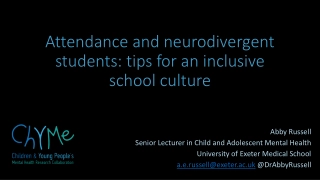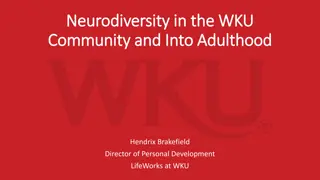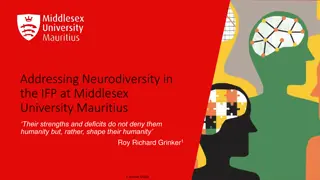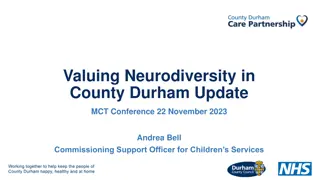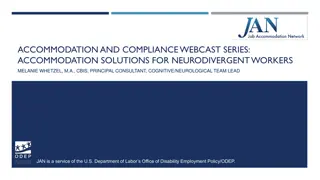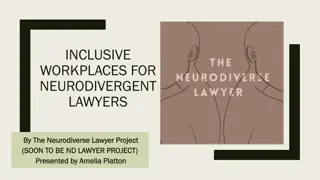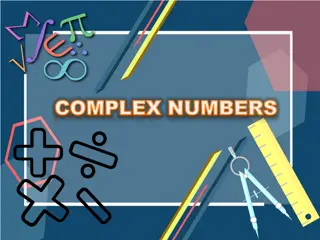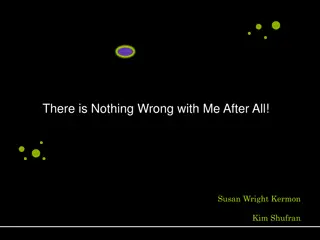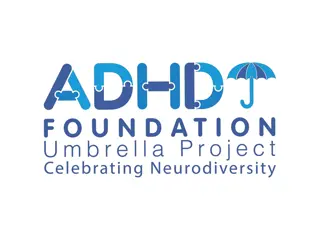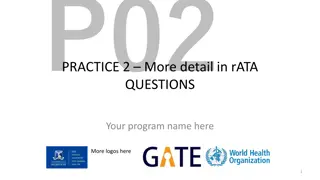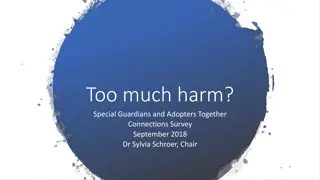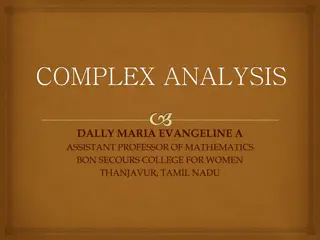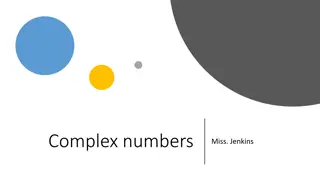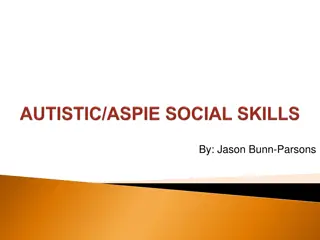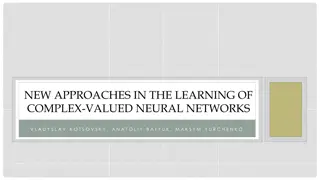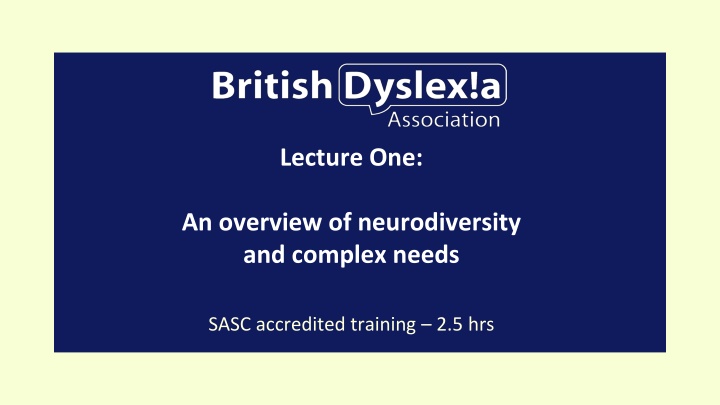
Neurodiversity: Co-Occurring Conditions Overview
Explore the interconnected nature of neurodiverse conditions such as ADHD, Autism, DLD, Dyscalculia, and Dyspraxia, and why assessors must be aware of overlapping difficulties for holistic support. Delve into the incidence of co-occurrence and the necessity for integrated approaches in addressing complex needs.
Download Presentation

Please find below an Image/Link to download the presentation.
The content on the website is provided AS IS for your information and personal use only. It may not be sold, licensed, or shared on other websites without obtaining consent from the author. If you encounter any issues during the download, it is possible that the publisher has removed the file from their server.
You are allowed to download the files provided on this website for personal or commercial use, subject to the condition that they are used lawfully. All files are the property of their respective owners.
The content on the website is provided AS IS for your information and personal use only. It may not be sold, licensed, or shared on other websites without obtaining consent from the author.
E N D
Presentation Transcript
Lecture One: An overview of neurodiversity and complex needs SASC accredited training 2.5 hrs
Course Outcomes An overview of Neurodiversity and complex needs A look at Attention Deficit Hyperactive Disorder (ADHD), Autism, Developmental Language Disorder (DLD), Dyscalculia and Dyspraxia and how these affect learners Overlapping strengths and difficulties between these neurodiverse conditions
The spectrum of neurodiversity Dyslexia Attention deficit hyperactivity disorder (ADHD) Developmental language disorder (DLD) Autism spectrum disorder (ASD) Dyscalculia Dyspraxia (DCD)
Why is it important for assessors to be aware of co-occurring difficulties? A poignant review of integrated and inter-professional working from Galvani and Forrester 2010 warns that users : Cannot be treated as bundles of complex problems each of which needs separate specialist input, but need a holistic service able to deal with such complex issues. (cited in Kirby 2017 p1)
Incidence of co-occurrence With any developmental disorder, there is extensive evidence of overlap being the rule rather than the exception Kirby (2017) As research continues it is becoming clear that many overlaps exist and that entirely pure cases of a single SpLD are unlikely. Hulme and Snowling (2009) 25% of those with either DCD, Dyslexia or ADHD were found to have all three 10% both ADHD and DCD 22% both dyslexia and DCD Kaplan et al 1998 cited in Kirby (2017)
Incidence of co-occurrence Dyslexia and DCD 70% of children with DCD also showing evidence of dyslexia and phonological problems (O Hare and Khalid, 2002) Dyslexia and ADHD 54% of children with ADHD in a clinical sample had reading difficulties (Stevenson et al, 2005)
Incidence of co-occurrence Dyslexia and Dyscalculia 40% of individuals with dyslexia have difficulties with mathematics. Lewis, Hitch, & Walker 1994 cited in Butterworth, Landerla and Bevana (2003)
Incidence of co-occurrence Dyslexia and DLD (Developmental Language Disorder) Reports of the prevalence of dyslexia in cases of early language impairment range from 25-90% (Tomblin et al., 2000). Dyslexia and Visual Difficulties Visual processing deficits and dyslexia have been found in two thirds of children attending the Oxford visual processing labs run by John Stein and his colleagues. (Stein and Walsh, 1997)
Who can diagnose at pre 16? Attention Deficit Hyperactive Disorder and Autistic Spectrum Condition diagnosed by a Paediatrician (via a GP referral or school/college) Developmental Language Disorder (DLD) Speech and Language Therapist
Who can diagnose at pre 16? Dyscalculia can currently only be diagnosed by a Psychologist or those with a Level 7 qualification (or equivalent) in Dyscalculia assessment. Dyspraxia can be diagnosed by an Occupational Therapist (via a GP referral)
Other areas Visual Difficulties refer to an optometrist Anxiety refer to psychologist (such as TAMHS/CAMHS) or a paediatrician
Overview of Needs Attention Deficit Hyperactive Disorder (ADHD) Autism (ASD/ASC) Developmental Language Disorder (DLD) Dyscalculia Dyspraxia
Attention Deficit Hyperactive Disorder (ADHD)ADHD The ADHD Foundation (2018) states: Attention deficit hyperactivity disorder (ADHD) is one of the most common childhood disorders and it can continue through adolescence and into adulthood. Symptoms include difficulty staying focused and paying attention, difficulty controlling behaviour, and hyperactivity (over-activity).
Impact of ADHD The main impact of having ADHD is on: Concentration Attention Impulsivity Hyperactivity
Indicators of Impact of ADHD DHD that will Inability to concentrate as well as other individuals their age Difficulty remembering instructions Moving around regularly, standing up, needing to fiddle with an object Yawning or appearing withdrawn (ADD now comes under the ADHD diagnosis) Recording of their learning can be messy and disorganised (particularly problematic in maths) Once in the teenage years, individuals with ADHD can be prone to depression
Overlap of Dyslexia and ADHD Gifted Creative Dyslexia ADHD Inconsistency Difficulties with Difficulties with: Lack of organisation decoding and spelling Attention Hyperactivity Impulse behaviour Poor memory Both thought to be genetic
Other resources for ADHD on ADHD Watch the YouTube video by Fin O Regan on What is ADHD? - listed at the end of this unit on the course site. ADHD Foundation - www.adhdfoundation.org.uk
Definition of Autistic Spectrum Disorder (ASD) The National Autistic Society (NAS) 2018 defines Autism as: A lifelong, developmental disability that affects how a person communicates with and relates to other people, and how they experience the world around them. The main areas of difficulty are with: Social communication Social interaction Social imagination
Main Behaviours associated with Autism Restricted and repetitive patterns of behaviours, activities or interests. The use of rules can be important. It may be difficult for the individual to take a different approach to something once they have been taught the 'right' way to do it. Sensory sensitivity foods, sounds, light, textures Individuals may appear more anxious and want very clear and specific instructions on how to complete a task They may want constant feedback on whether they have been right or wrong on each question and being wrong could make them anxious. Poor social skills/communication
Overlap of Dyslexia and Autism Autism Gifted Dyslexia Difficulties with social communication and interaction. Anxiety Difficulties with Decoding and spelling Creative Poor organisation Can be high functioning and good readers and spellers Writing can be challenging
Further information about Autism National Autistic Society: www.autism.org.uk Lisa Roger s book Visual Supports for Visual Thinkers
Developmental Language Disorder (DLD) Developmental Language Disorder (DLD) was formerly known as Specific Language Impairment. It is one aspect of difficulties which students may experience who struggle with language and communication.
DLD Definition Talking Point, a children s language charity defines Developmental Language Disorder (DLD) as: Developmental Language Disorder (DLD) is a term that is used to describe difficulties with learning and using language which will be long term, but that are not associated with other conditions, such as cerebral palsy, or autistic spectrum disorders.
Main areas of difficulty and impact of DLD Difficulties accessing the curriculum due to challenges with acquiring secure reading comprehension and (sometimes) accuracy skills Impaired short term memory Difficulties developing vocabulary, understanding and recalling instructions
Main areas of difficulty and impact of DLD Find it challenging to record thoughts and ideas coherently and to show their true level of knowledge and understanding increases as the individual gets older. Children with undiagnosed receptive or expressive language difficulties are often hidden, appearing to be quiet or perhaps behave inappropriately; they will struggle to make expected progress without support.
Overlap of Dyslexia and DLD Short term memory DLD Dyslexia Following instructions Difficulties with decoding and spelling Difficulties with expressive and receptive language Planning and Organisation Phonological awareness
Dyscalculia Dyscalculia is a difficulty acquiring mathematical skills related to number and number sense. A learner with dyscalculia will have difficulty with simple number concepts, they will lack an intuitive grasp of numbers and have difficulty learning number facts and procedures.
Dyscalculia Definition Dyscalculia is a specific and persistent difficulty in understanding numbers which can lead to a diverse range of difficulties with mathematics. It will be unexpected in relation to age, level of education and experience and occurs across all ages and abilities. Mathematics difficulties are best thought of as a continuum, not a distinct category, and they have many causal factors. Dyscalculia falls at one end of the spectrum and will be distinguishable from other maths issues due to the severity of difficulties with number sense, including subitising, symbolic and non-symbolic magnitude comparison, and ordering. It can occur singly but often co-occurs with other specific learning difficulties, mathematics anxiety and medical conditions. (Jarrett 2019)
Main areas of difficulty/indicators of Dyscalculia Lacks confidence in Maths Poor estimation skills and an inability to subitise Finds it difficult to make connections between aspects of number Struggles to recall basic facts Difficulties with ordering numbers and finding patterns
Overlap of Dyslexia and Dyscalculia Sense of direction Dyslexia Dyscalculia Sequencing Difficulties Difficulties with number concepts, estimation and subitising Concept of time with decoding and spelling, visual confusion, left/right confusion Processing information Short-term memory
Dyspraxia and DCD Dyspraxia is a subtype of Developmental Co-ordination Disorder (DCD) It is accepted that Dyspraxia and DCD are terms used interchangeably They affect movement and co-ordination Their must be a history of motor difficulties for a diagnosis Non-motor difficulties can be present but without a motor element a diagnosis of DCD would not be given
Main areas of difficulty for learners with dyspraxia Whilst there are several definitions of dyspraxia the main areas of difficulty are generally agreed to be: Fine and gross motor skills Speech and language Whole body movements such as co-ordination and balance
Main impact for learners with dyspraxia The main impact is on: Physical skills such as movement Communication Handwriting and drawing skills Planning Play
Overlap of Dyslexia and Dyspraxia Laterality Following instructions Attention Dyspraxia Dyslexia Sense of direction Sequencing Poor muscle tone, body awareness, sensory integration and motor planning Difficulties with decoding and spelling Copying from the board Concept of time Processing information Short-term memory
Further Information on Dyspraxia on dyspraxia Latest guidance document is available on the SASC website (under downloads) as well as a very useful presentation from the SASC June conference by Amanda Kirby available at: http://www.sasc.org.uk/SASCDocuments/Presentation- Screening%20for%20DCD%20SASC%2014%20June%202018.pdf You Tube video on What is Dyspraxia? available on the course site
Key indicators of type of difficulty Specific Difficulty Key Indicator Dyslexia Literacy skills and processing Dyspraxia Motor control and planning Dyscalculia Number sense and estimation ADHD Attention and hyperactivity ASD Social communication and interaction DLD Expressive and receptive language Visual discomfort and disturbance Visual Difficulties Anxiety Nervous and either withdrawn/ hyper
Common Difficulties across needs & dyslexia Phonological Processing Working memory Speed of processing Attention Organisation Time management Listening skills Sensory perception Speed of processing Impact on Literacy skills
Lecture Two Considerations when assessing learners with complex needs Two case studies: Background information, quantitative and qualitative information Making a diagnostic decision Appropriate recommendations
References ADHD Foundation ADHD Foundation (2018) accessed at: https://www.adhdfoundation.org.uk/ (Accessed on 4th July 2018) Patrick, A. The Dyspraxic Learner (2015) London: Kingsley Rogers, L. (2013) Visual Supports for Visual Thinkers London: Kingsley The Dyspraxia Foundation accessed (2018) Available at: https://www.dyspraxiauk.com/dyspraxiafoundation.php (Accessed on 20th June 2018)
Thank you! www.bdadyslexia.org.uk | @bdadyslexia


